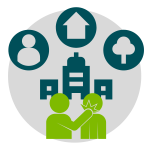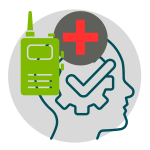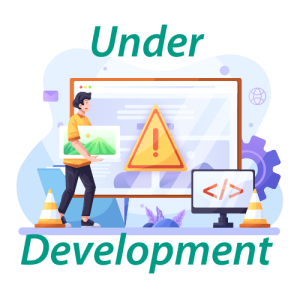Workplace Violence and Harassment Tools in Independent Living, Home Care, and Senior’s Housing

Step 1: Securing Leadership Commitment
Employers have the greatest responsibility with respect to health and safety in the workplace. The employer, typically represented by senior management, is responsible to take every practicable step for the protection of a worker. They are also responsible for developing and implementing the workplace occupational health and safety program and ensuring that the Internal Responsibility System (IRS) is established, promoted, and functions successfully to continually audit, evaluate, and improve the program. Strong leadership by senior executives, managers, and supervisors is essential to setting the tone and establishing a strong safety culture.
By reviewing and following an accountability framework, the organization can work towards the same goal of preventing violence and harassment in the workplace.
According to Alberta OHS Act Part 1: Obligations of Work Site Parties:
- Employers must ensure workers are not subject to or participate in harassment or violence at the work site.
- Supervisors must ensure workers under their supervision are not subject to harassment or violence at the work site.
- Workers must refrain from causing or participating in harassment or violence.
The organization can also establish a Workplace Violence Prevention Committee as a subcommittee of the HSC to oversee the program and ensure the Workplace Violence and Harassment Prevention Plans are followed and regularly evaluated.
Leadership and Accountability Tools
Can be used as a guidance tool for organizations to outline who is accountable for certain aspects of the Violence and Harassment Prevention Program

Step 2: Assessing Your Program
Once you have secured leadership commitment and all worksite parties are aware of their responsibilities, it is essential that workers, employers, the HSC/HSR and unions participate and cooperate to identify and assess risks in the workplace.
Everyone should be involved in this process. workers, supervisors, health and safety and/ or workplace violence prevention committees, health and safety representatives, and/or unions to develop a successful workplace violence and harassment prevention program.
Assessment Tools
A tool that helps LTC homes work with their JHSCs to determine where they are in their workplace violence prevention journey and where they need to improve.
 Contains tools designed to assist workers in independent living, community care and senior’s housing to identify hazards, establish their risk rating, identify controls and implement an action plan.
Contains tools designed to assist workers in independent living, community care and senior’s housing to identify hazards, establish their risk rating, identify controls and implement an action plan.
This toolkit includes the risk assessment tools and the detailed information on how to use it.
A series of questions employers can ask staff to help understand employees’ concerns and perceptions with respect to violence in their workplace. It is important to involve workers in the assessment process to identify their perception based on their experience and awareness. It also provides workers the opportunity to exercise their right to participate.
This tool will assist caregivers to reflect on caregiving safety measures and person-centred care strategies.

Step 3: Developing Program Components
Organizations must design a Workplace Violence Prevention Program that consists of a workplace violence prevention policy and a program that includes; reporting, response and investigation procedures; environmental control procedures; work practice and administrative control procedures.
The Alberta Occupational Health and Safety Code also lists down the requirements every employer must develop and implement in their workplace harassment and violence prevention plans.
The plans must:
- include a prevention policy and prevention procedures
- be in writing and readily available for reference by workers at the work site, either in paper or electronic format.
Policies and procedures
- Policies set overall expectations that harassment and violence are not tolerated in the work environment.
- Procedures outline the methods or processes required to make the policy work on a day-to-day basis and establish a way of doing things that the employer and workers are to follow.
Following Step 2, once the risks and hazards specific to the work environment are identified, the ogram components are now determined as needed. The following Violence, Aggression, and Responsive Behaviors (VARB) Toolkits were specifically adapted to support individual program components recommended as best practice. Other additional tools and resources are available to support the development of program components.
VARB Toolkits
 The Violence Assessment Tool provides a snapshot of a client’s immediate risk of violence by identifying behaviours associated with increased risk. With this insight, healthcare teams can efficiently assess the risk, apply control interventions if needed, and improve worker safety while helping to increase quality of care.
The Violence Assessment Tool provides a snapshot of a client’s immediate risk of violence by identifying behaviours associated with increased risk. With this insight, healthcare teams can efficiently assess the risk, apply control interventions if needed, and improve worker safety while helping to increase quality of care.
Following extensive stakeholder consultation, the VAT was adapted from the BrØset Violence Checklist and the Dynamic Appraisal of Situational Aggression instrument for use in multiple care settings.
The VAT contains two sections:
1. Behaviours observed and history of violence and a Risk Rating Scale to determine whether the client’s risk level is low, moderate, high or imminently high
2. Action items/Interventions
The VAT should be completed at first contact with the client, and according to your organization’s policies and procedures — e.g. in acute care this might be once every shift; in long-term care, it might be between prescribed Ministry documentation such as RAI-MDS or RAI-HC. Depending on the client’s individual circumstances, further assessment may be required.
Download the ICRA Toolkit for Community Care/Senior’s Living
 Employers, supervisors, staff — they all have a role to play in eliminating violence at work. Employers however have ultimate responsibility. They must also provide all workers at risk with information (including personal information) about a person with a history of violence. Workplaces, in turn, must adopt effective prevention strategies. One such strategy is a flagging-alert program to communicate violence-related risks to healthcare teams. By taking this kind of proactive approach to managing violent, aggressive and responsive behaviours, we can reduce the risk of harm to workers while providing patients with the best possible care.
Employers, supervisors, staff — they all have a role to play in eliminating violence at work. Employers however have ultimate responsibility. They must also provide all workers at risk with information (including personal information) about a person with a history of violence. Workplaces, in turn, must adopt effective prevention strategies. One such strategy is a flagging-alert program to communicate violence-related risks to healthcare teams. By taking this kind of proactive approach to managing violent, aggressive and responsive behaviours, we can reduce the risk of harm to workers while providing patients with the best possible care.
This FLAGGING handbook provides practical tools and information that will help organizations develop a sustainable flagging-alert program.
The handbook includes:
- A Flagging overview on the purpose, benefits and types of flagging, and related legal and ethical responsibilities
- The five key steps to developing a Flagging Program
- Appendix – A Sample Flagging Policy

This toolkit is designed to help health and community organizations establish an effective PSRS. It aims to describe the PSRS, how the PSRS is a component of existing programs, processes and frameworks within an organization, and the need to consider PSRS as a system and not merely devices. The tool kit provides practical information that includes:
- Legislative requirements related to PSRS
- Definition of a PSRS and PSRS devices
- Alignment of PSRS to emergency management and a workplace violence program
- A systematic approach to developing and implementing a PSRS using Plan-Do-Check-Act
- The importance of PSRS devices, procedures and training programs
- General description of PSRS devices
- Tools to assist organizations to:
- Check legislative compliance
- Assess PSRS gaps and develop an action plan
- Assess and determine their PSRS device needs
- Evaluate selected PSRS devices
- Develop PSRS policy, procedures and training
- Create awareness

This toolkit is designed to help health and community organizations establish an effective PSRS. It aims to describe the PSRS, how the PSRS is a component of existing programs, processes and frameworks within an organization, and the need to consider PSRS as a system and not merely devices. The tool kit provides practical information that includes:
- Legislative requirements related to PSRS
- Definition of a PSRS and PSRS devices
- Alignment of PSRS to emergency management and a workplace violence program
- A systematic approach to developing and implementing a PSRS using Plan-Do-Check-Act
- The importance of PSRS devices, procedures and training programs
- General description of PSRS devices
- Tools to assist organizations to:
- Check legislative compliance
- Assess PSRS gaps and develop an action plan
- Assess and determine their PSRS device needs
- Evaluate selected PSRS devices
- Develop PSRS policy, procedures and training
- Create awareness
Tools to Support the Development of the Program Components
The Violence Assessment Tool provides a snapshot of a client’s immediate risk of violence by identifying behaviours associated with increased risk. With this insight, healthcare teams can efficiently assess the risk, apply control interventions if needed, and improve worker safety while helping to increase quality of care.
Following extensive stakeholder consultation, the VAT was adapted from the BrØset Violence Checklist and the Dynamic Appraisal of Situational Aggression instrument for use in multiple care settings.
The VAT contains two sections:
1. Behaviours observed and history of violence and a Risk Rating Scale to determine whether the client’s risk level is low, moderate, high or imminently high
2. Action items/Interventions
The VAT should be completed at first contact with the client, and according to your organization’s policies and procedures — e.g. in acute care this might be once every shift; in long-term care, it might be between prescribed Ministry documentation such as RAI-MDS or RAI-HC. Depending on the client’s individual circumstances, further assessment may be required.
Download the ICRA Toolkit for Community Care/Senior’s Living
Employers, supervisors, staff — they all have a role to play in eliminating violence at work. Employers however have ultimate responsibility. They must also provide all workers at risk with information (including personal information) about a person with a history of violence. Workplaces, in turn, must adopt effective prevention strategies. One such strategy is a flagging-alert program to communicate violence-related risks to healthcare teams. By taking this kind of proactive approach to managing violent, aggressive and responsive behaviours, we can reduce the risk of harm to workers while providing patients with the best possible care.
This FLAGGING handbook provides practical tools and information that will help organizations develop a sustainable flagging-alert program.
The handbook includes:
- A Flagging overview on the purpose, benefits and types of flagging, and related legal and ethical responsibilities
- The five key steps to developing a Flagging Program
- Appendix – A Sample Flagging Policy
Resource to assist caregivers with identifying common patient triggers and mitigate risk of workplace violence through individualized care plans and other risk minimizing strategies.
Resource to help patients and families understand their role in their care and ability to contribute to a safe and healthy work environment, and sample brochure for patients, family members and visitors.
Download Engaging Residents and Families in Violence Prevention
This tool will assist caregivers to reflect on caregiving safety measures and person-centred care strategies.

Implementing Your program
After determining the components of the program, an action plan should be generated in order to facilitate the implementation. Implementing the program includes communication, marketing and education. Organizations also need to create a communication plan that involves how the the whole program or its components will be implemented strategically.
Worker training
Employers must instruct workers on:
- the hazard of workplace harassment and violence
- how to recognize the signs of danger
- what to do about it
- how to report it
Tools to Support Implementation
The Violence Assessment Tool provides a snapshot of a client’s immediate risk of violence by identifying behaviours associated with increased risk. With this insight, healthcare teams can efficiently assess the risk, apply control interventions if needed, and improve worker safety while helping to increase quality of care.
Following extensive stakeholder consultation, the VAT was adapted from the BrØset Violence Checklist and the Dynamic Appraisal of Situational Aggression instrument for use in multiple care settings.
The VAT contains two sections:
1. Behaviours observed and history of violence and a Risk Rating Scale to determine whether the client’s risk level is low, moderate, high or imminently high
2. Action items/Interventions
The VAT should be completed at first contact with the client, and according to your organization’s policies and procedures — e.g. in acute care this might be once every shift; in long-term care, it might be between prescribed Ministry documentation such as RAI-MDS or RAI-HC. Depending on the client’s individual circumstances, further assessment may be required.
Download the ICRA Toolkit for LTC/ Facility Living
Long-term care Violence Assessment Tool (VAT)

Evaluating Your Program
Review of plans
According to Alberta OHS, the plans must be reviewed every 3 years or more often if there is an incident of harassment or violence or if the health and safety committee or representative requests a review.
The review should focus on whether the policy or procedures are current and if there are any deficiencies or gaps that need to be addressed.
Other Resources to Support Your Program

Following the CCSA Process for the Violence and Harassment Program Review, we have developed a guide to show an overview of what the process looks like.
What's Next?
Not sure where to start? Contact the CCSA OHS Team for guidance or advice regarding your organization’s workplace violence and harassment prevention programs.
Ontario's PSHSA Violence and Aggression Resources Terms of Use
Accessing the PSHSA violence prevention materials for use in the Province of Alberta is with the agreement that the terms and conditions will be met under the license agreement between PSHSA and the CCSA.
The resources in the CCSA Violent and Harassment Prevention Program are aligned with the content from PSHSA violence prevention materials. These documents and resources may have references to the Ontario context and legislative requirements specific to the Province of Ontario. Though the CCSA has adapted these for use in Alberta, users of these resources are still advised to reference the Alberta OHS legislation.

